
(photo credit: Tommy Agriodimas / Downtown Alliance)
click here for larger image
I’ve long admired Diana Horowitz’s paintings and I was thrilled to have the opportunity to speak with her on the phone and by email for this interview. I thank her greatly for the generosity of her time and thoughts for this interview.
Maureen Mullarkey wrote in February 2008 in the New York Sun:
“Diana Horowitz is a deeply appealing painter. She works within the tradition of open-air painting dear to artists from between the 17th and 19th centuries. Making gracious use of her antecedents, she balances the improvisational appeal of plein air against the demands of unromantic modern constructions.”
The September 2011 issue of Artists Magazine a feature article by Judith Fairly states:
Diana Horowitz rode her bicycle to lower manhattan and painted views of the city from the observation deck on the 107th floor of the World Trade Center, first as a graduate student and later as part of a studio program. after the Twin Towers fell in 2001, she scouted around for a new location from which to paint and eventually landed on the 48th floor of the newly reconstructed 7 World Trade Center (WTC), where she has a 360- degree view of the city. “I’ve had an affinity for high vantage points for as long as I can remember,” she says. “I think that’s because of the way things become more abstracted.”
This article examines Horowitz’s work process in depth with many images and is a fascinating and informative read.
(entire article can be read from this link)
Diana Horowitz lives and teachs in NYC. Horowitz is represented by Hirschl & Adler Modern, New York City. Horowitz received a BFA from the State University of New York at Purchase College and her MFA from Brooklyn College. She is an Adjunct Associate Professor of Painting at Brooklyn College and has taught painting and drawing at the School of the Art Institute of Chicago, Tyler School of Art in Rome as well as teaching at many visiting artist venues. Horowitz is the recipient of many prestigious awards and residencies including being elected member of the National Academy, a Pollock-Krasner Foundation Grant, and residency at Yaddo and the MacDowell Colony. She has been featured in numerous solo and group exhibitions across the country since 1985 and is included in the collection of the Brooklyn Museum of Art, the New-York Historical Society and the Museum of the City of New York, among others.
Diana Horowitz is participating in two group landscape shows, one at the Staten Island Museum in fall 2014, and one at Adelphi University in Long Island, NY December 6th through January 10, 2014.
Larry Groff: I’m curious about some of your early influences as a painter. Your mother is a painter, who makes abstracted landscapes of Cape Cod and studied with Hans Hofman and at Cooper Union School of Art in NYC. You also grew up in the Westbeth Artist Coop in NYC’s Greenwich Village where you likely came into contact with numerous influential personalities. Any interesting stories about how your early years shaped who you are today?
Diana Horowitz: I feel very lucky to have grown up in such an unusually artistic environment. Most of my parents’ friends were painters and we always seemed to be around other artists, not only in New York, but during the summers that I spent in Provincetown as well.
One of my early influences was a family friend named Arthur Cohen, who died just last year. He was a perceptual painter who studied with Edwin Dickinson. His work is not very well-known now, but he was a marvelous and sensitive painter with a beautiful sense of color and touch. I own quite a few of his paintings and I still love them. He gave me a lot of support. Other early influences were Selina Trieff and Robert Henry.
I definitely learned a number of early lessons from this exposure. One lesson was that rejection is a big part of the life of a painter and that it is important to not let it get to you. Second, I saw how the green monster of jealousy can be a destructive force. And third, I saw friends of my parents who never sold a painting in their lives and then at age 65 suddenly had a big career — as well as the reverse. It made me aware of how important the long view is.
Also, I was exposed very early to many different types of work so I took a certain amount of pluralism for granted. The majority of the artists I encountered were color-field painters, hard edge abstractionists, conceptual artists, and abstract expressionists. There were fantastic figurative painters as well, but they were people like Bob Thompson, Bob Beauchamp, and Jan Mueller all of whom I think would be considered more expressionist. It was less common for me to encounter painters interested in perceptual painting, so I started out with a pretty snotty attitude about representational painting.
When I became interested in “realism” I felt a little like a black sheep. So many of the artists I knew as a young girl were people who had studied with Hans Hofman — nearly all of my parents’ friends. But looking back I am amazed by the number and variety of artists I knew, and how deep the bench was, Hans Haake, Diane Arbus, Mary Frank, Elizabeth Murray, Pat Lasch, Nassos Daphnis, Anne Tabachnik, Robert DeNiro Sr., Nicolas Carone. Now, it’s true that I encountered half of these people through my active babysitting services and a lot of this contact was wasted on me. I realized 20 years later who Hans Haacke was after years of babysitting for his kids as well as Elizabeth Murray’s son (that was when I was 12 and it was only once or twice). I learned that Diane Arbus came to my house to look at my brothers to photograph although apparently they didn’t fit her needs (way too cute) but she spent a lot of time photographing another friend of mine. I also babysat for Milton Avery’s grandson in a house filled with his paintings way before I could really appreciate his work.
One embarrassing story I have was when I was in college my boyfriend worked for Frank Stella in his shop and he gave me a signed original silk screened Frank Stella t shirt that was a very limited edition. It was actually really beautiful. I was such an idiot that I wore it to painting class to impress my teacher Robert Swain a color field painter and got it covered in paint. I’m sure he was impressed with what an ass I was.

New York Harbor & Ellis Island 13″ x 26″ 1997
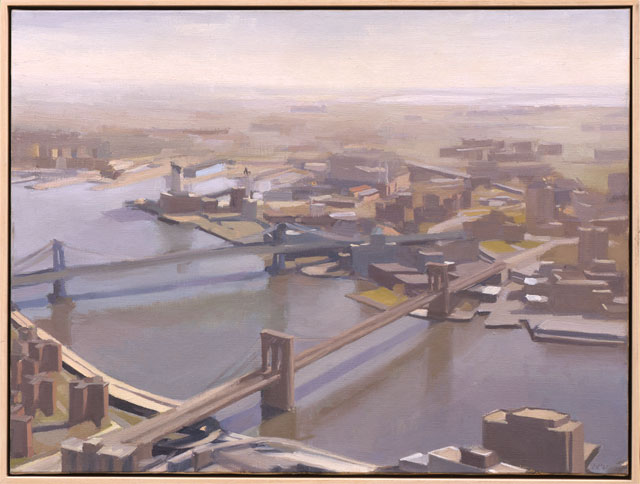
East River and Bridges 15″ x 20″
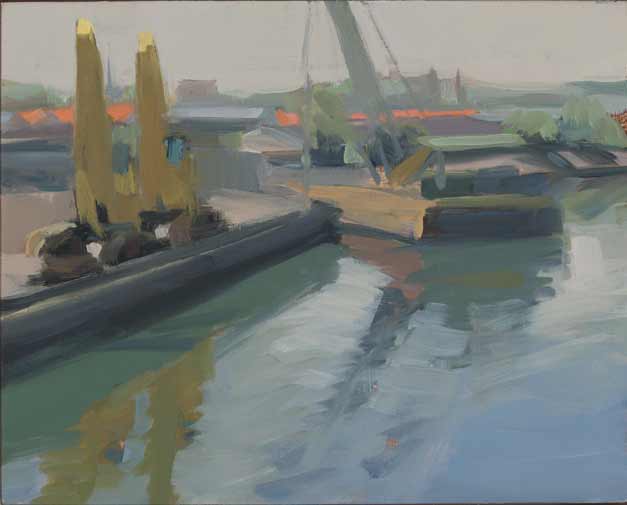
Barge and Cranes 7 1/2″ x 10″ oil on muslin covered panel 2013
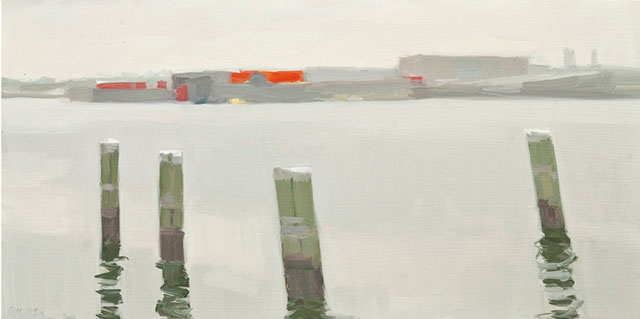
Pylons and Bayonne, 2009 Oil on panel 6″x11.75″
LG: You studied with Lennart Anderson at Brooklyn College. I’m wondering what you might be able to share about some aspect of his teaching that has been most important to you?
DH: Lennart was a brilliant teacher and had and still does have an incredible eye. I am still amazed by how he can hit the nail on the head when looking at painting and identify a problem or problems, even with his failing eyesight. I don’t really know how he does it.
Three points that I took away from his painting class, which I probably have misremembered after all this time are:
- Look for and establish the darkest dark and the lightest light.
- If you see tones together, paint them together and then make the difference.
- Strong shapes can keep a painting from becoming academic.
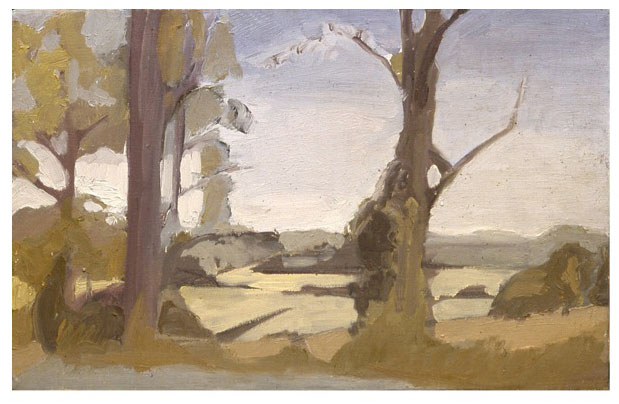
First outdoor landscape: 1979
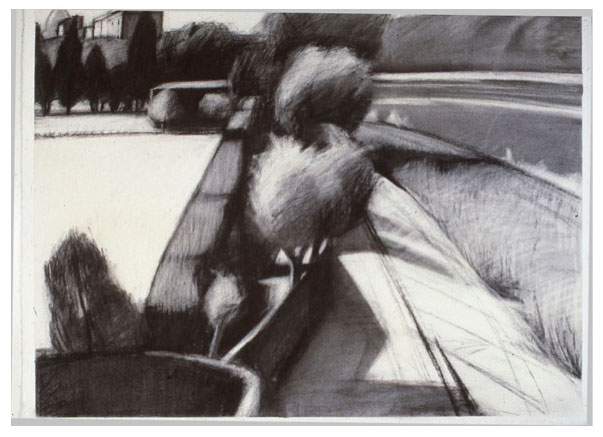
Drawing 1983 Tiber
LG: What was your painting like when you first got out of school? What are some of the biggest changes you’ve gone through with your work?
DH: My last year of undergraduate school I did my first outdoor landscape painting with a cardboard box of paints and no easel, just kneeling on the ground. That was basically it. I was totally hooked. When I graduated I moved to an island in Maine and then Vermont for 2 years. I did odd jobs, mostly waiting on tables.
I kind of started from scratch trying to teach myself how to paint light. I painted every day, sometimes in temperatures down to about 10 below zero. Really stupid because not only did I get frostbite but my paintings from that period are absolutely wretched. I did do a lot of charcoal drawings and my drawings were miles and miles ahead of the paintings. Pretty much everyone let me know that.
LG: You lived in Rome for four years and have spent many summers there, can you tell us something about your experience there?
DH: My time in Italy was completely life-changing for me. I fell in love with so much Italian painting from Pompeii wall paintings to Morandi, from Lorenzetti to the Scuola Romana. Equally important to me was the work by foreign artists inspired by the Italian landscape: Corot, Ingres, Balthus, Turner, and Albert Marquet. I took pilgrimages to the Louvre to see the Corots and Marquet which was a revelation. And I became committed to perceptual painting.
Another important aspect of my time in Italy was the friendships I made. Amy Weiskopf and I became roommates and have remained good friends for 30 years. (She and I had both gone to graduate school at Tyler in Rome). Amy, Constance LaPalombara, Margaret McCann, Jeanne Duval and I spent many summers painting together in various configurations and it was great and a lot of fun. We worked like slaves and really pushed each other.
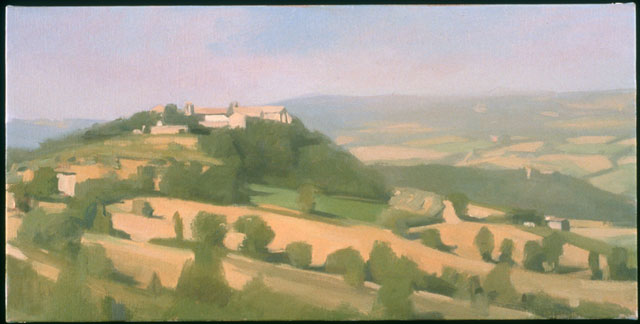
Monte Santo, Morning 10”x20” oil on linen, 2001
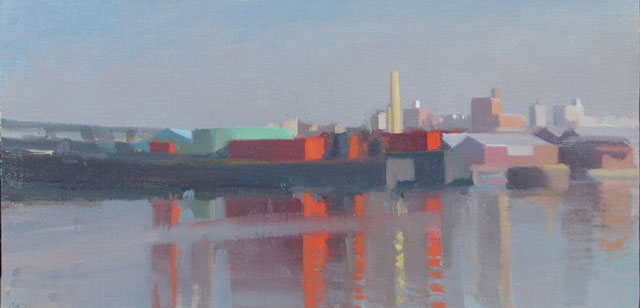
Red Reflections, 2006 Oil on linen 6″x11.75″
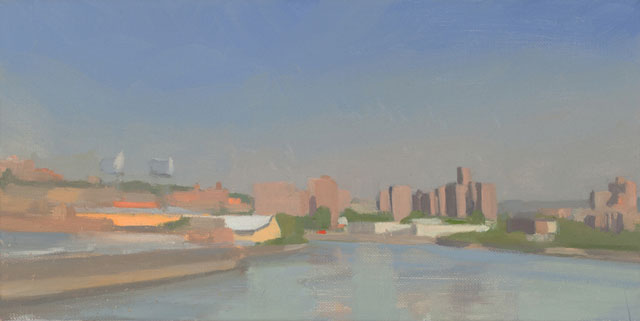
Manhattan Meets the Bronx, 2011 Oil on linen 6″x12″
LG: You stated that you found measuring a way of keeping a painting fresh and open “because my measurements are always changing and I am continually reestablishing them. Also measuring is a way of creating relationships in a painting.” But you go on to say that this measuring: “is not an ethos with me and I find that at some point measurements don’t work and intuition takes over.” – from the article in Artist Magazine.
Do you think the process of rigorous investigation, measuring and comparing the painting to the observed motif enables you to better step outside of yourself? Do you think it is desirable to become less self-conscious and let intuition take over while painting, if so why?
DH: I tend to be an intuitive person and painter. I often find that careful measuring takes me away from my natural way of seeing so I tend to avoid doing too much of it.
I am constantly amazed by how hard painting can be especially when you are standing comparing the painting to the observed motif. Sometimes when I am having a frustrating time with a painting I’ll call up my friend John Dubrow for help, and at this point it’s kind of a joke. He tells me to step way back from the painting. 90 percent of the time that really helps. He doesn’t even need to see the painting. The other 10 percent of the time I need to use a bigger brush.
LG: How much freedom do you allow yourself to deviate from the observed situation? Would you ever change the specifics of a building or group of structures to better suit your composition? Do you think that restrictions from the particulars of the motif can paradoxically offer greater freedoms?
DH: I usually don’t invent things or move things, but I will bend or stretch or shrink things to fit a compositional need, not always consciously.
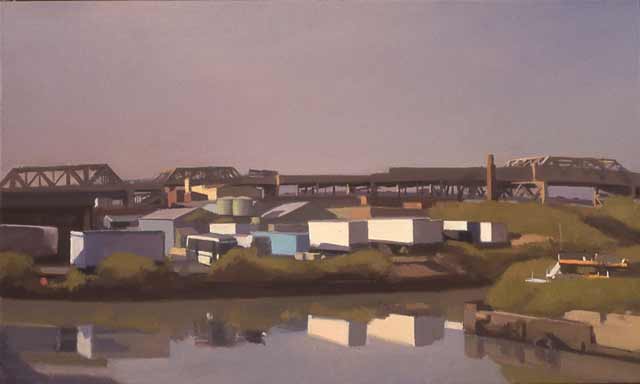
From 3rd Street Bridge, 1996 Oil on linen 12″x18″
Downtown Brooklyn from HSBC 16″ x 16″ oil on linen 2000
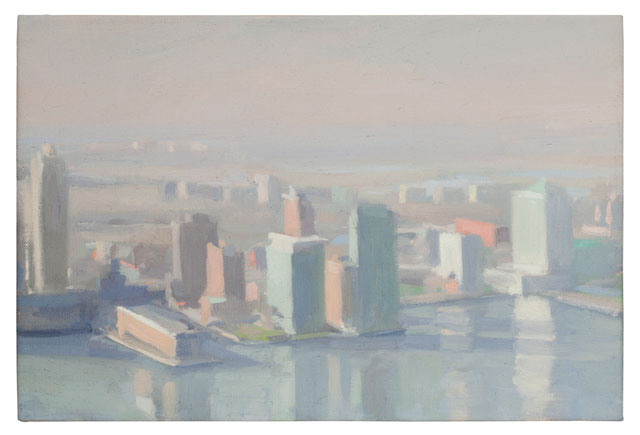
New Jersey from 7 World Trade 8”x12” oil on linen, 2010
LG: Many of your paintings depict elevated views of the city. What is the draw of this subject for you and how has your approach has changed over the years? Does painting at street level have any appeal for you?
DH: I do paint a lot at street level and have over the years, but I have loved being high up for as long as I can remember. Usually if I paint from high up for a period I will need a couple of months on ground level after that. I believe my first 10 years living in Washington Heights at one of the highest points in Manhattan with a view from the ninth floor toward the Cloisters created some kind of archetypal inner landscape. I actually often dream about being high up looking out that ninth-floor window. I think the way things flatten out and become abstracted in the distance is part of what has attracted me to the distant views. When I moved down to the West Village at age 11, I spent many hours playing on the rooftop at Westbeth as well as on the abandoned piers along the West Side Highway. My first series of drawings from life were of those abandoned piers and I think that urban industrial landscape has an attraction for me because of that.
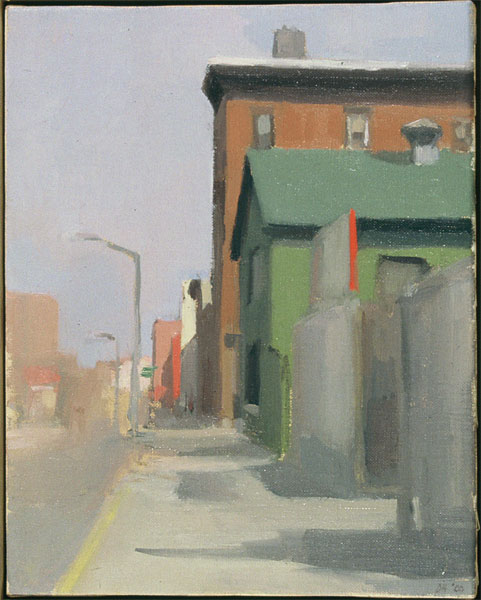
Union and Hoyt, 2002 Oil on linen 10″x8″
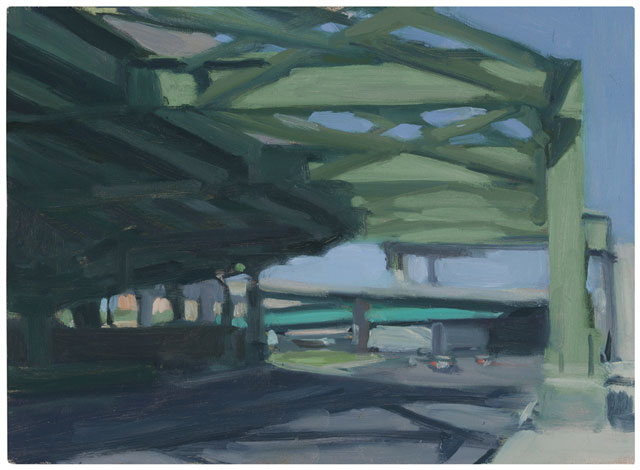
From 3rd Ave. and 20th Street, 2013 Oil on panel 8″x11″
LG: Some cityscape painters show highly detailed renderings of buildings complete with countless precisely drawn windows, storefront reflections, brickwork, etc. Many of these works can be compelling and masterful such as with Richard Estes or Rackstraw Downes. However, lessor painters, seem to forget the bigger picture and get so bogged down with exhausting relentless details that they might as well be typing “all work and no play makes Jack a dull boy” over and over. Do looser paintings have more fun and does this fun make them better? What gives you the greatest pleasure in painting and what do you need in order to get to that place?
DH: My work has less and less detail as time goes on and seems to have gotten less realistic. This is really not something that I made a conscious decision to change.
I tend to love many other people’s tight paintings but not my own, in fact a lot of my favorite paintings are not at all loose. My favorite thing in life is to start new paintings or to do small quick studies. As with many painters, finishing paintings is not the fun part for me. I have a hard time with knowing when to stop, or with bringing paintings to some kind of resolution. I have constant battles with myself trying to keep a painting open and finish it without killing it.
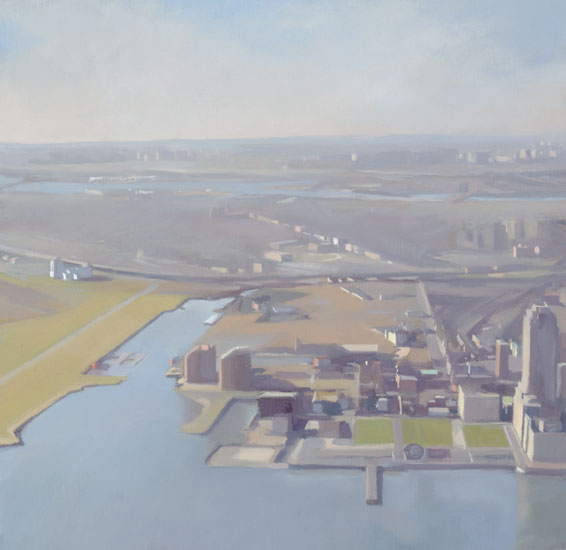
New Jersey from the W.T.C 16”x16” oil on linen, 1997
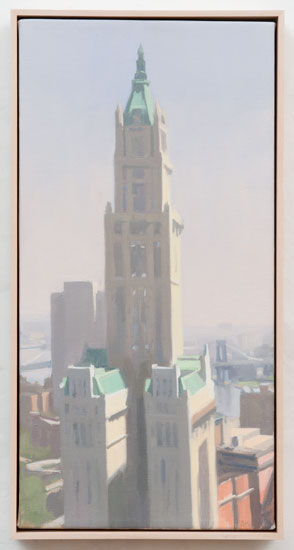
Woolworth Building Hazy, 2007 20″ x 10″
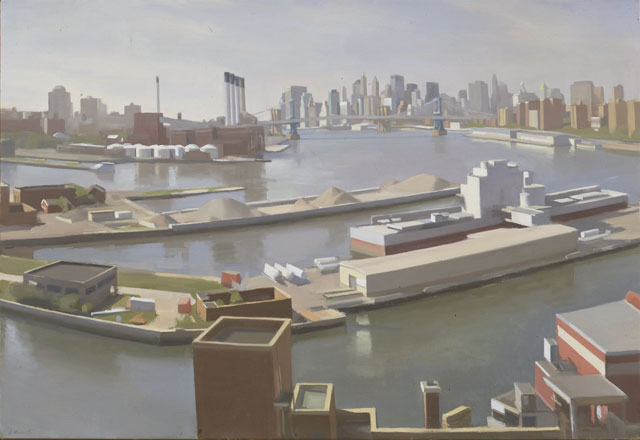
Wallabout Basin 22”x32” oil on linen, 2004
LG: Is there danger in being too formal? That the desire for emotional detachment and the fear of sentimentality can make paintings seem boring to the non-painting public at large? Should we care?
DH: I am a bit of an unrepentant formalist. I don’t think that necessarily means emotional detachment or fear of sentimentality. I think a really great formal painting can be kind of transcendent. I just saw a show of Ad Reinhardt which was so powerful and emotional and they would probably be considered boring by some, as well as formal. Achieving that level of transcendence is a whole different thing though.

High Bridge, 2011 Oil on linen 8″x12″
LG: Abstract painting creates art that is less about something and more about being a thing in itself. Which has led to much hand-wringing over not denying the fact of the picture’s flatness. Your recent abstract paintings appear to be filled with atmosphere, space and light yet are simple square and rectangular shapes of color with no drawn suggestions of spacial recession. Can you tell us something about your thoughts behind these abstract works, especially with regard to space? Is this a direction you plan to explore further?
DH: I thought of those abstractions as a hobby. I was interested in making paintings with atmosphere and balance that related to my cityscapes. I did them for many years at the same time I was continuing my other work. I may go back to that sometime but the interesting thing about exhibiting them was it took away some of my desire to make them. I think I could see that they mostly weren’t really very good. I am very impressed with how Helen Miranda Wilson was able to persevere when she moved away from landscape to abstract paintings and I really love the abstractions she is doing now. She worked through it and I like what she’s doing now as much or more than her landscapes. So that might inspire me to try again, but working out doors is very addictive and it is almost impossible for me to imagine not doing it for very long.
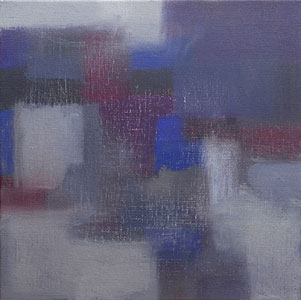
Cobalt, 2008 Oil on linen, 13 3/4 x 13 3/4 in.
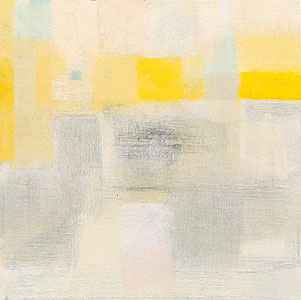
Yellow Square, 2007 Oil on linen, 16 x 16 in.
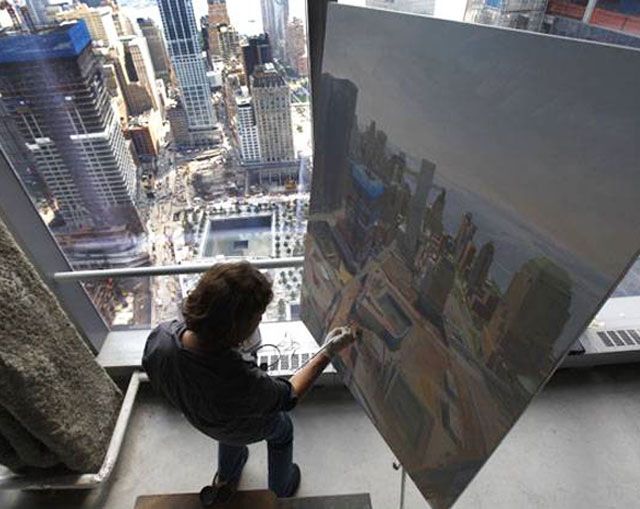
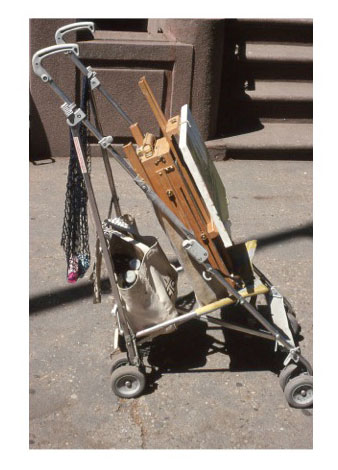
LG: Over the years you’ve had a successful career as a painter while juggling teaching and raising a family. Can you tell us something about your experience that might be helpful to someone else with similar issues?
DH: Being a working mother is challenging no matter what you do. Being a working painter raises some particular challenges. In general there is an attitude that painting is not a job so you should be available to do everything for everyone. I think women might have a harder time saying no, and that is probably the thing I wish I had a class in before the balancing act. Also learning to say no, without immediately adding, “and if you can’t find someone else you can call me back!”
After being something of a work-a-holic, I had a big adjustment to having so much less time to work. I do think I learned to use my time more efficiently. My advice is: learn to say no, don’t hate your painter friends who have no kids, and children grow up very quickly so don’t be too hard on yourself.
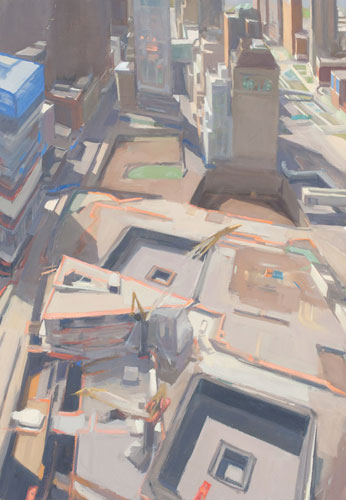
Reflecting Pools, 2011 Oil on linen 26″x18″
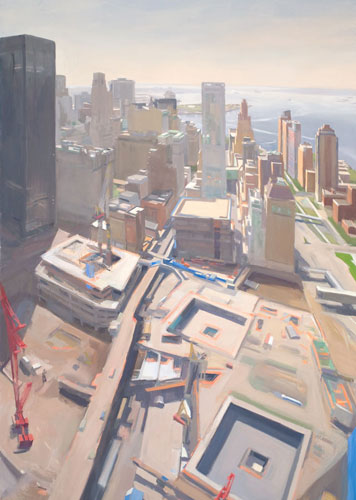
World Trade Center Reflecting Pools and Harbor, 2011 Oil on linen 42″x30″

World Trade Center Reflecting Pools and Harbor #3, 2011 Oil on linen 42″x30″
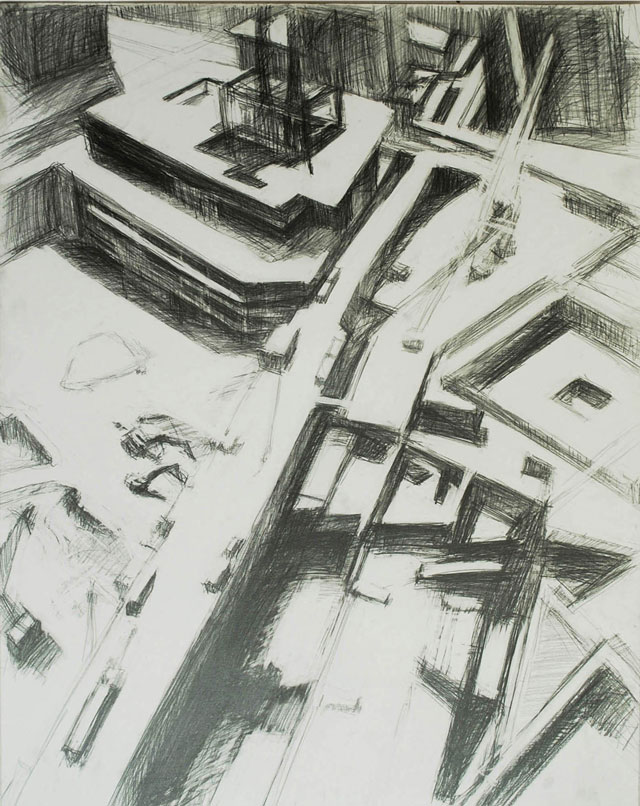
Ground Zero Construction, Vertical, 2011 Graphite on paper
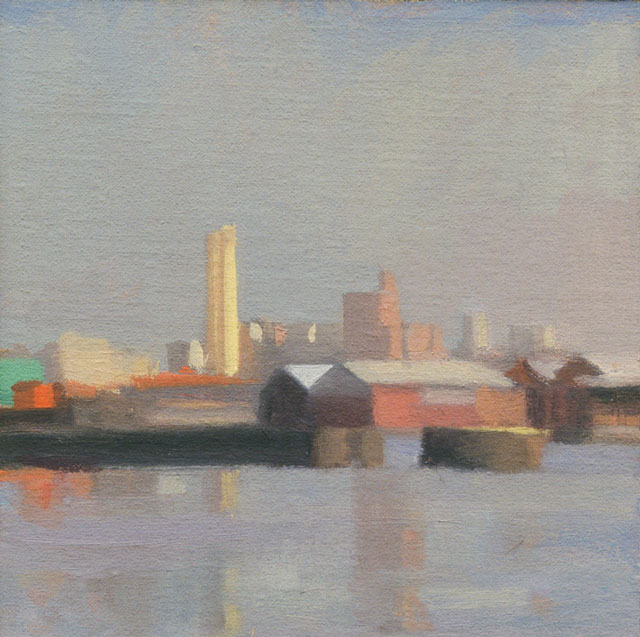
Yellow Smokestacks, 2006 Oil on panel 6″x6″
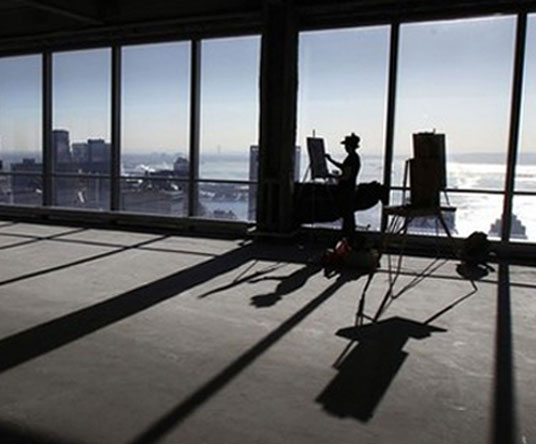

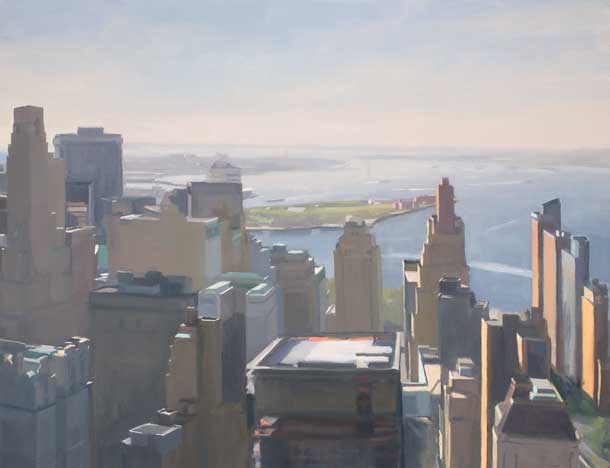
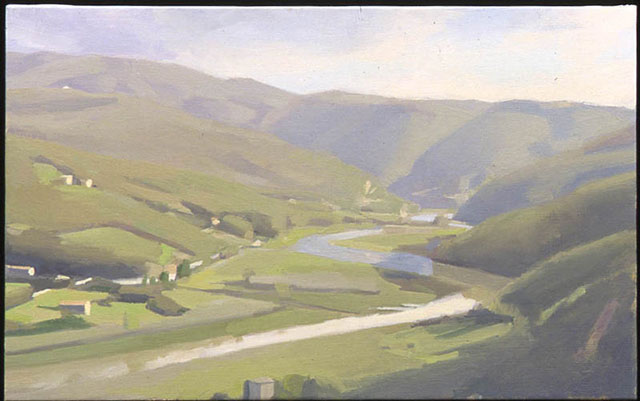
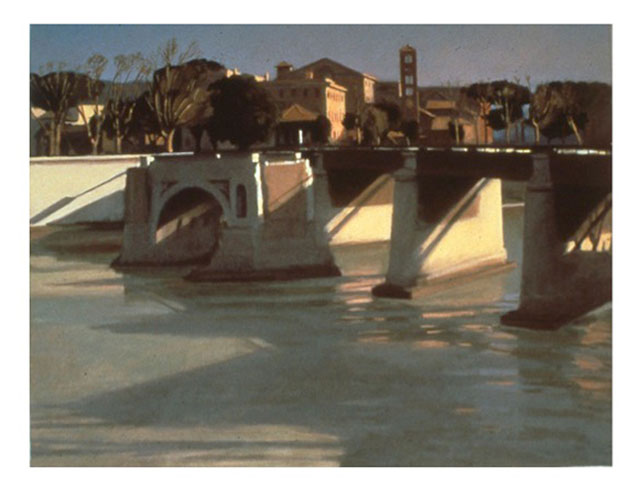
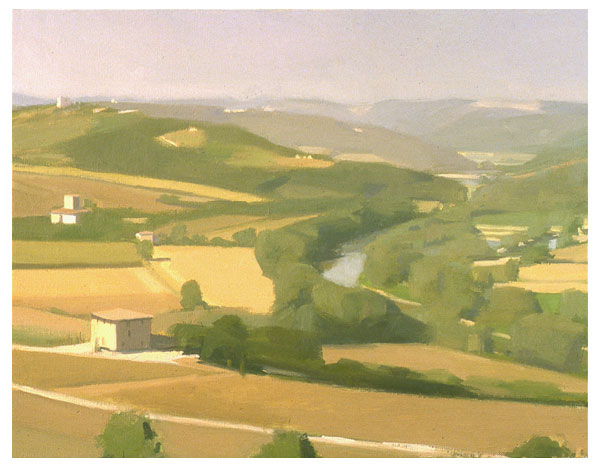
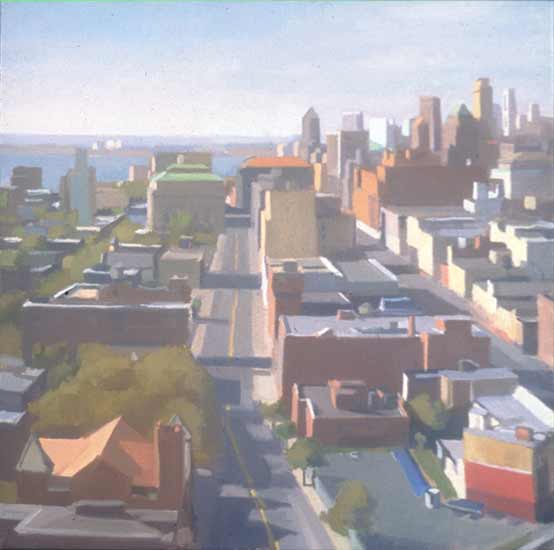

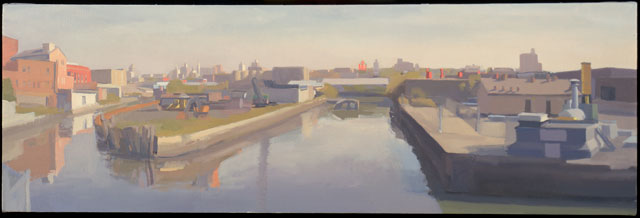




Great interview – shows her depth and humor. Diana was always popping up in Rome painting; I’d run into her on my way to teaching gigs in the historical center – in the Orange Garden on the Aventino or below at Circo Massimo; near Isola Tiburina or some ponte; lucky to own a few of her paintings!
Beautiful and airy work. Thanks for the terrific interview! I remember those paintings from your wall Margaret!
Great questions that bring out Diana’s thoughtfulness, integrity and humor. Very inspiring.
Great interview. Inspiring to read.
Big fan of Diana’s work…great to finally see her here. Her sense of light, tone and atmosphere is amazing. thanks for the great interview. now I know what to do with that old baby stroller too…
Brava, Diana! Thank you, Larry.
Wonderful interview. And great to see so many paintings I haven’t seen before. I, too, so appreciate her humor.
thanks for a great interview Larry and Diana!
Great interview. Such amazing, precise color key and light, and solid compositions. Never leaves the sense of place, but maintains a great awareness of the abstract. Loved the 2 really abstract pieces too!
Another fine interview Larry. I have enjoyed Diana’s work for some time and found the candid nature of the interview refreshing.
What a wonderful interview and introduction to Diana’s work. It is so encouraging to learn about she deal with art and life.
This is a wonderful interview. I have long been a fan of Diana’s work and it’s good to see such a variety shown here. She paints such confident forms and bathes them in exquisite atmospheric light; very neo-classical. Her humor and modesty come across here too.
That was a very interesting interview. I like the paintings and enjoyed the stories
Great interview and beautiful work.
A very enlightening and interesting read, thank you very much indeed!
Dear Ms. Horowitz,
I have followed and loved your work for almost twenty years; I was introduced to it by Susanna Coffey and Dan Gustin at SAIC in the mid-90’s. Sadly I attended after you taught there and did not get a chance to learn directly from you.
If you have the time to answer the following questions I would really appreciate it, but if you can’t or don’t want to I completely understand that you are busy with more important things.
Do you approach your work with a kind of surprise-seeking, experimental curiosity or do you make paintings to investigate preconceived ideas that you have regarding composition, or pictorial space, color and light, or some other personal artistic interest? Also, would you comment on whether you think academic skills (linear and atmospheric perspective, chiaroscuro, constructive anatomy, indirect techniques in drawing and painting) are important for contemporary artists to learn in college art programs? Does directness relate to authenticity?
Thank you,
Noel
Great style and use of colour. You might like to look at Mario Finlayson’s work from Gibraltar.
I really was very impressed by your work,never having seen it before.Larry Groff has listed my talk on the teaching methods of Edwin Dickinson on this site, I think, as you teach you may find it usefull, or it is on my web site,left corner top as “lecture”
As you painted on top of the W T C did you run into my friend Tom Loepp, who , in the90’s painted a number of views from there?
i really enjoyed this interview. I really connect with the small scale 6×6 “yellow smokestack” piece… simple shapes with bits of color.. really beautiful…
Brava!